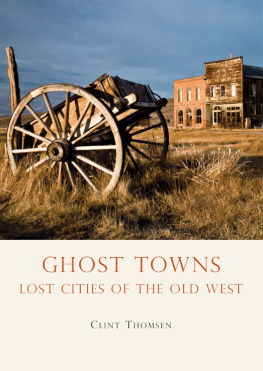

GHOST TOWNS
of the SOUTHWEST
Your Guide to the Historic Mining Camps
& Ghost Towns of Arizona and New Mexico

Text by Jim Hinckley
Photography by Kerrick James

First published in 2010 by Voyageur Press, an imprint of MBI Publishing Company, 400 First Avenue North, Suite 300, Minneapolis, MN 55401 USA
Copyright 2010 by Jim Hinckley and Kerrick James
All rights reserved. With the exception of quoting brief passages for the purposes of review, no part of this publication may be reproduced without prior written permission from the Publisher.
The information in this book is true and complete to the best of our knowledge. All recommendations are made without any guarantee on the part of the author or Publisher, who also disclaims any liability incurred in connection with the use of this data or specific details.
We recognize, further, that some words, model names, and designations mentioned herein are the property of the trademark holder. We use them for identification purposes only. This is not an official publication.
Voyageur Press titles are also available at discounts in bulk quantity for industrial or sales-promotional use. For details write to Special Sales Manager at MBI Publishing Company, 400 First Avenue North, Suite 300, Minneapolis, MN 55401 USA.
To find out more about our books, visit us online at www.voyageurpress.com .
Digital edition: 978-1-61673-895-2
Softcover edition: 978-0-7603-3221-4
Library of Congress Cataloging-in-Publication Data
Hinckley, James, 1958
Ghost towns of the Southwest: your guide to the historic mining camps and ghost towns of Arizona and New Mexico / text by Jim Hinckley; photography
by Kerrick James.
p. cm.
Includes index.
ISBN 978-0-7603-3221-4 (sb : alk. paper)
1. Ghost townsArizonaGuidebooks. 2. Ghost townsNew MexicoGuidebooks. 3. Mining campsArizonaGuidebooks. 4. Mining camps
New MexicoGuidebooks. 5. ArizonaGuidebooks. 6. New MexicoGuidebooks. I. James, Kerrick. II. Title.
F812.H56 2010
917.91dc22
2009023427
ISBN-13: 978-0-7603-3221-4
Editor: Amy Glaser
Design Manager: LeAnn Kuhlmann
Cartographer: Patti Isaacs, Parrot Graphics
Series Designer: Cindy Samargia Laun
Layout Designer: Cindy Samargia Laun
Cover Designer: John Barnett / 4 Eyes Design
Printed in China
Frontispiece: OK Corral Shootout Graves, Tombstone, Arizona.
Title page: Spider Rock, Canyon de Chelly, Arizona.
Title page inset: Living room, Strafford Hotel, Shakespeare, New Mexico.
CONTENTS
INTRODUCTION
Arizona and New Mexico make up a large portion of the Southwest. More than 234,000 square miles of amazing geographic and geologic diversity; stark, sterile desert plains; towering snow-capped mountains; deep red rock canyons where thundering waterfalls spill into turquoise blue pools; and alpine meadows bordered by forests of towering pines are contained within these man-made borders.
For centuries, these gorgeous landscapes have served as the backdrop for a cavalcade of human history. Almost a thousand years before Columbus sailed the ocean blue, the Anasazi built cities that were engineering marvels among the towering canyon walls here. The Hohokam built villages in the fertile soils of the desert river valleys and transformed the surrounding arid lands into a paradise with the masterful development of an irrigation system that lasted long after their settlements had disappeared from the horizon.
The Spanish Conquistadors came in search of gold and souls, brought civilization to the ancestors of the Anasazi, and built villages of their own, often on the ruins of those that came before. With the passing of years, the winds of time reclaimed many of these.

Vestiges from more than a century of mining litter the rugged and scenic landscapes of the Cerbat Mountains in northwestern Arizona.

With Castle Dome as a backdrop, this old ore car is a fitting memorial for a town whose mining history spans more than a century.
American traders, explorers, and adventurers seeking a faster route to the gold fields of California rolled west and discovered unexpected treasures along the way. Fueled by fortunes of pelts and gold, silver and empires of cattle, timber and the railroad, a new wave of towns and cities sprang from the rugged lands.
Isolated desert valleys became modern, bustling metropolises in mere weeks and became as empty as the Anasazi canyon homes just as quickly. More than a few of these towns are immortalized as legends forever associated with larger-than-life figures: Tombstone and Wyatt Earp, Lincoln and Billy the Kid, and Fairbank and Jeff Milton.
Over time, the dusty desert winds reclaimed the valleys, and time swept the names of once prosperous communities from the map, as well as memory. Soon only picturesque ruins and legends remained.
A few villages that survived as shadows of their former glory found new life in new booms. Others clung to life as an outpost in a harsh land for a new breed of adventurers: motorists. In time, many of these villages succumbed to the changing times, and another sea of ghost towns dotted the desert plains.
Today the ruins framed by majestic scenery and breathtaking landscapes stand in silent testimony to the power of hopes and dreams. The towns that cling to life with dust swirling along once busy thoroughfares and those that remain as faint traces in the desert sands lure visitors with scenic wonder, tangible links to a colorful history, or the prospect of lost treasure.
As you seek these lost worlds, remember those who once called them home and give thought to those who will follow your visit. Take nothing but photographs and memories; leave nothing but footprints. Plan your trips carefully. Many of these town sites are in very remote locations and summer temperatures in the desert often exceed 110 degrees. Mine shafts and tunnels are unstable and should be approached with extreme caution.
Last but not least, please watch out for snakes. Snakes seek cooler places in the opening of tunnels, under rocks, and in crevasses to escape the heat so be careful where you step or place your hands.

The historic Brown Store in White Oaks has been pulled back from the precipice of abandonment and is one of the few remnants of a once-thriving business district.

Next page











